The One Thing Every Creator Needs for a 6 Figure Business

By Connor
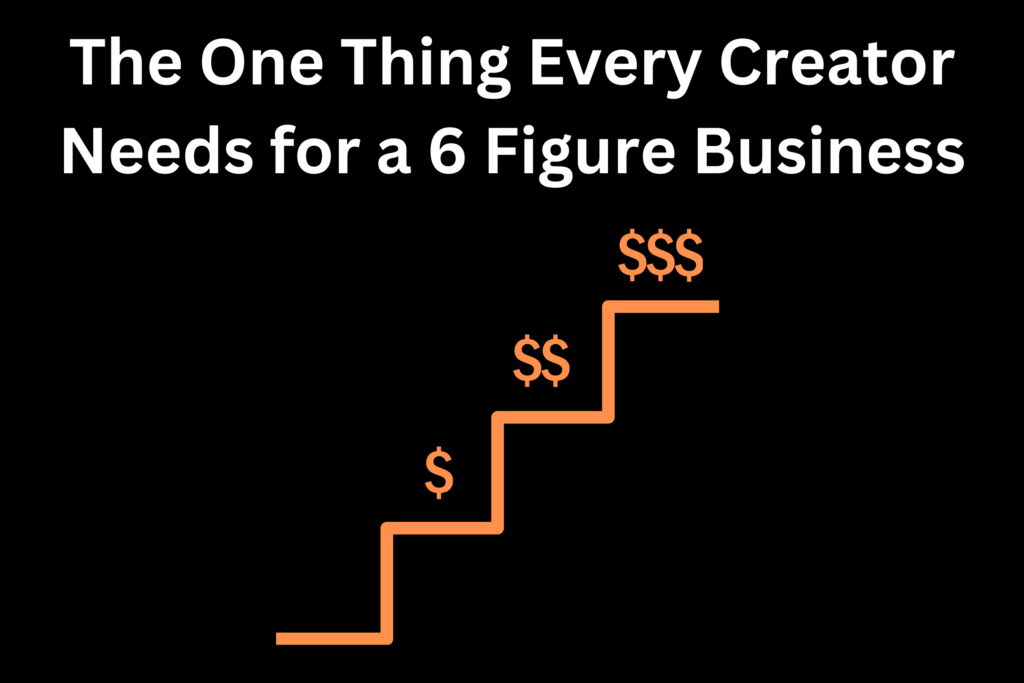
There is one thing that every creator, solopreneur, coach, consultant, grandmother, and grandfather needs: a value ladder.
At it’s core, it’s one of the simplest components of your business, but it’s also the most important.
It informs everything you do and everything you create. It becomes the foundation of mapping your customer journey. It lets you serve more people AND make more money (the ultimate double whammy in business).
But what is a value ladder exactly?
I’m so glad you asked.
What is a Value Ladder
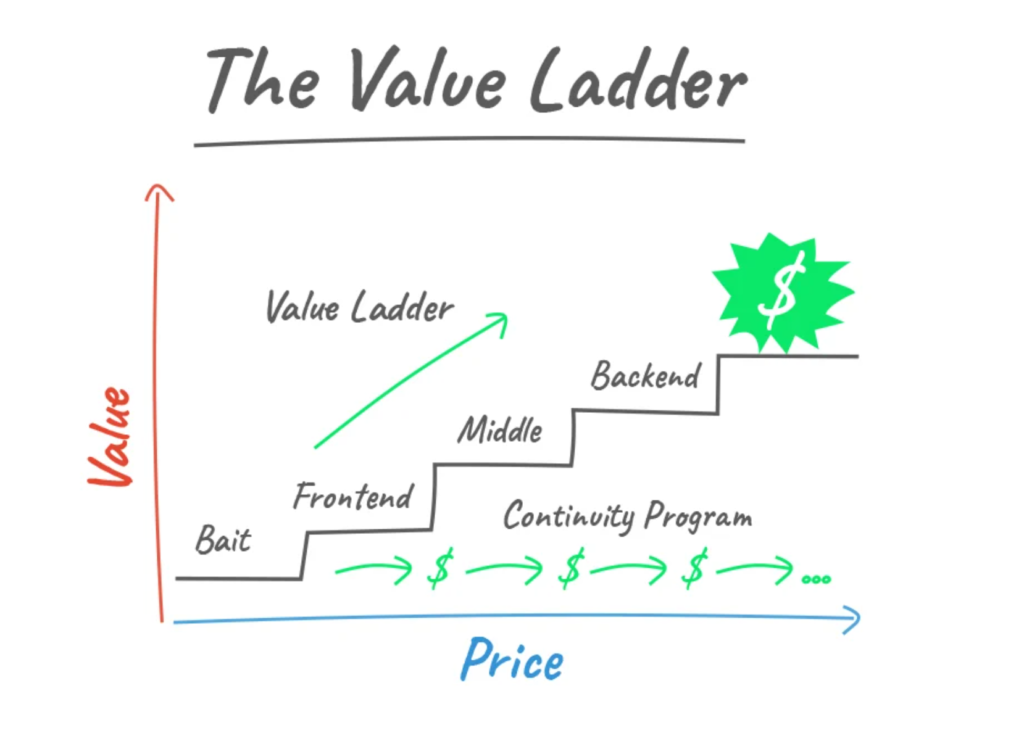
The value ladder has been around FOREVER, but it really came into the limelight because of Russell Brunson, the king of value ladders and funnels.
PS – if you can’t tell by how much I reference him and his frameworks, Russell Brunson has had a HUGE impact on the way I think about online business.
The concept is simple.
Bring people into your ecosystem with free “bait” and then progressively add more and more value (while also charging them higher prices) until you bring them all the way up to your highest-ticker offer.
If you recall our discussion of fish and whales from last week, this is exactly the framework you use.
You cast a wide net and bring a TON of fish into your world with ridiculously high value and low cost (or free) products. Then each rung up on the ladder is reserved only for the people who are willing, able, and ready to buy your higher ticket products/services.
It’s how you create RAVING fans.
Think about it. You don’t immediately ask somebody to marry you. You have a conversation first. If that goes well, you go on a date. If that goes well, you go on a second date. If it keeps going well, you keep going up on the “dating” ladder until you get married.
The value ladder lets you do the same thing but with your business.
Your lead magnets are the conversation.
Your front-end offer is the first date.
Your middle offer is the bulk of the relationship.
Your backend offer is the proposal.
And your apex offer is marriage.
Value Ladder Components
A value ladder is made up of 6 principal components:
- Your free offer
- Your front-end offer
- Your main offer
- Your backend offer
- Your apex offer
- Your continuity offer
One thing to point out right from the start is that not every business and certainly not every value ladder will have all 6 components.
As long as you have at least 2 of the 6, you’ve created a value ladder.
Don’t get trapped into thinking that more is better.
In fact, often times, the simpler the better. Unless you’re crystal clear about what each step is and how it relates to your customer journey, a 5 or 6 step value ladder can get confusing for you to create and your customers to work through.
Start small and grow from there.
The godfather of value ladders himself doesn’t recommend going on to a different value ladder until you’ve hit at least $1M in revenue from the one you currently have.
Yep, they can make you that much money.
The Free Offer (Bait)
The first step in crafting an irresistible value ladder is the bait.
Something that you give away for FREE that packs a TON of value.
The primary objective is to get a prospect’s contact information. You can stop there or immediately send them to an exclusive One Time Offer (OTO) to turn them from a lead to a customer (more on that in a minute).
Some of the most popular free offers to try are:
- eBooks
- Guides
- Quizzes
- Cheat sheets
- Email courses
- Free consultations
I’ve personally only experimented with guides, eBooks, and free consultations, but I’ve got my eye set on an email course next.
Don’t limit yourself here. While these are some of the most popular lead magnets out there, you can (and should) get creative. Align how you like to create and what your strengths are with the lead magnets you create.
The Frontend Offer
You can also think of this as your “Welcome Offer.”
After people have given you their contact information, they are PRIMED for a paid offer.
A simple, $7-$97 welcome offer can immediately take them from lead to customer.
Don’t expect frontend offers to make you rich. They can inject some cashflow into the business, but they have 2 primary benefits:
- They can help you cover ad spend
- They give you data about who you’re attracting and what they want
The 2nd bullet is more important in my opinion.
You can treat each frontend offer as a “mini-offer” for larger products/services.
For example, assume you split test 2 different products.
One is for social media growth. The other is for email list growth. The outcome of the test will tell you exactly who you’re attracting and what they want to see more of.
If they social media growth product does better, you can now think about building a larger course, running a webinar, or even offering coaching on social media growth. But if the email list growth product does better, then you can start thinking about more in depth products around email marketing.
The frontend offer will also let you know who you’re attracting.
If you’re trying to attract email marketers to your ecosystem but your social media growth offer is doing better, it’s a sign that the messaging or targeting in your content and ads may be off.
So yes, a frontend offer can help you make a little bit of money. But the real value comes from the data you collect (that being said check out Mike Romaine to see how he added $50k in yearly revenue to superherojacked.com with a simple welcome offer).
The Main Offer
After your customers go through the first 2 rungs, you’ve provided a TON of free/cheap value. This is where they take the leap to something a little more expensive.
It should be the MAIN thing that you sell. A higher priced course, a subscription service, a cohort, a coaching program, etc.
The first 2 rungs brought people into your ecosystem. Now, you’re nurturing them and filtering out the people who either a) can’t afford a higher-ticket service or b) have no interest in something more valuable than your first 2 offers.
There’s nothing wrong with the people who don’t make it to the main offer. Maybe they make it this far in the future. Maybe they don’t.
That’s irrelevant.
You can’t realistically sell EVERYONE on your main thing. But the people who do make it through the first 2 rungs are MUCH more likely to move on to your main offer than somebody who didn’t even give you their email.
You leverage one of the most powerful forces in business: prospect inertia.
They said yes once and got value, so they’re MUCH more likely to say yes again, even at a higher price.
That’s the power of building out a strong value ladder.
The Backend Offer
Now we’re getting even more selective.
A good amount of prospects will become customers with your main offer. But for the majority, this is where their journey stops.
They’ve gotten a TON of value from you already, and it’s had a large enough impact on their business, health, finances, relationships, etc. that they don’t need anything else from you (at this time).
But you’ll have a handful of people who want more.
They’ve gotten such good results from your main offer, they want to take it up a step and see what else they can do.
For example, JK Molina runs a community called Cash Creators. The main offer is access to his community. The backend offer is personal 1:1 access to him.
Not everyone in the community will take the backend offer. The community itself is valuable enough, but some people want more. They want 1:1 coaching calls with JK. They want him to help them build their offers.
So these are the people who upgrade to the backend offer. They’ve already seen success and they are highly committed to your products & services. They’ve bought into your ethos, and they want more.
The Apex Offer
This is the granddaddy of all the offers. Ideally, you’d get every single one of your customers to this point, but realistically, only a very small percentage ever make it this far.
At this stage, you offer the MOST value for the HIGHEST price. It’s reserved for only those customers that have truly excelled with all of your previous products/services.
For example, let’s look at weight loss:
You went from a weight loss handbook → weight loss app → customized meal plan → customized weight loss program (diet, exercise, sleep, etc.)
What would the last rung look like?
Giving them a personal chef to do all of their shopping and cook all of their meals for them.
If I told a chef exactly what to make you in exactly what proportions, there’s basically ZERO chance you don’t lose weight.
The perceived value is so high that it’s almost impossible for a dedicated customer who has the desire and the means to say “no.”
The Continuity Offer
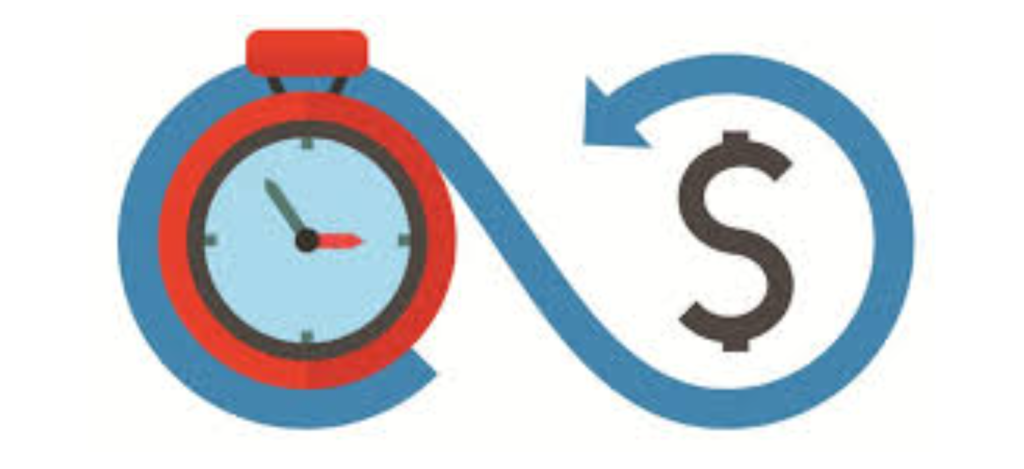
A continuity offer is where you make your recurring revenue.
For a gym, it would be memberships
For coaches, it would be a community
For landscaping, it would be weekly cuts
For doctors, it would be yearly checkups
For SaaS companies, it would be software
Think of things that people repeatedly have to do on a weekly, monthly, quarterly, or yearly basis.
Not every business will have a continuity offer. It simply fits some models better than others (SaaS!). But even if you think there’s now way for you to add a continuity offer to your business, stretch yourself. There are almost always ways to add recurring revenue to your offer (even if it’s relatively small!).
Macro vs. Micro Value Ladders
Now that we’ve seen WHAT a value ladder is, it’s important to break it down a little further into macro value ladders and micro value ladders.
The concept is exactly the same. The only difference is where/how you apply it.
A macro value ladder is a high level view that you use for your ENTIRE business.
It brings prospects through the whole ecosystem of what your company offers.
It’s serves as a roadmap for what you do and how you get your prospects from A to Z.
On the other hand, a micro value ladder is designed for a SPECIFIC offer.
Think of it like a value ladder WITHIN a value ladder – a “sub-value ladder” if you will.
It could be for things like…
- Courses
- Cohorts
- Book drops
- Communities
Let’s make all of this a little more concrete and take a look at one of my favorite fitness accounts around: Renaissance Periodization. This is their overall macro-value ladder:
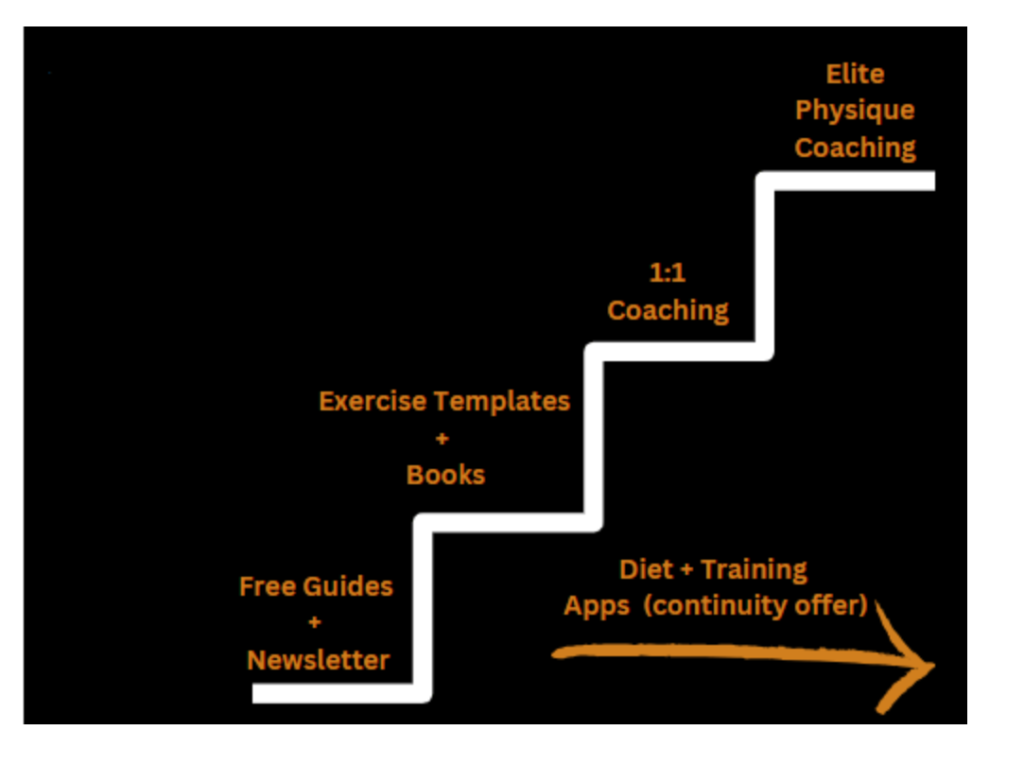
It brings prospects all the way from free guides and newsletters to elite physique coaching.
This is the high level overview of how RP Strength moves people through it’s business. It’s how they go from A to Z.
In contrast, we can zoom in on one of their micro-value ladders for dieting.
It starts with a free guide and ends with an exclusive offer for their RP Diet App.
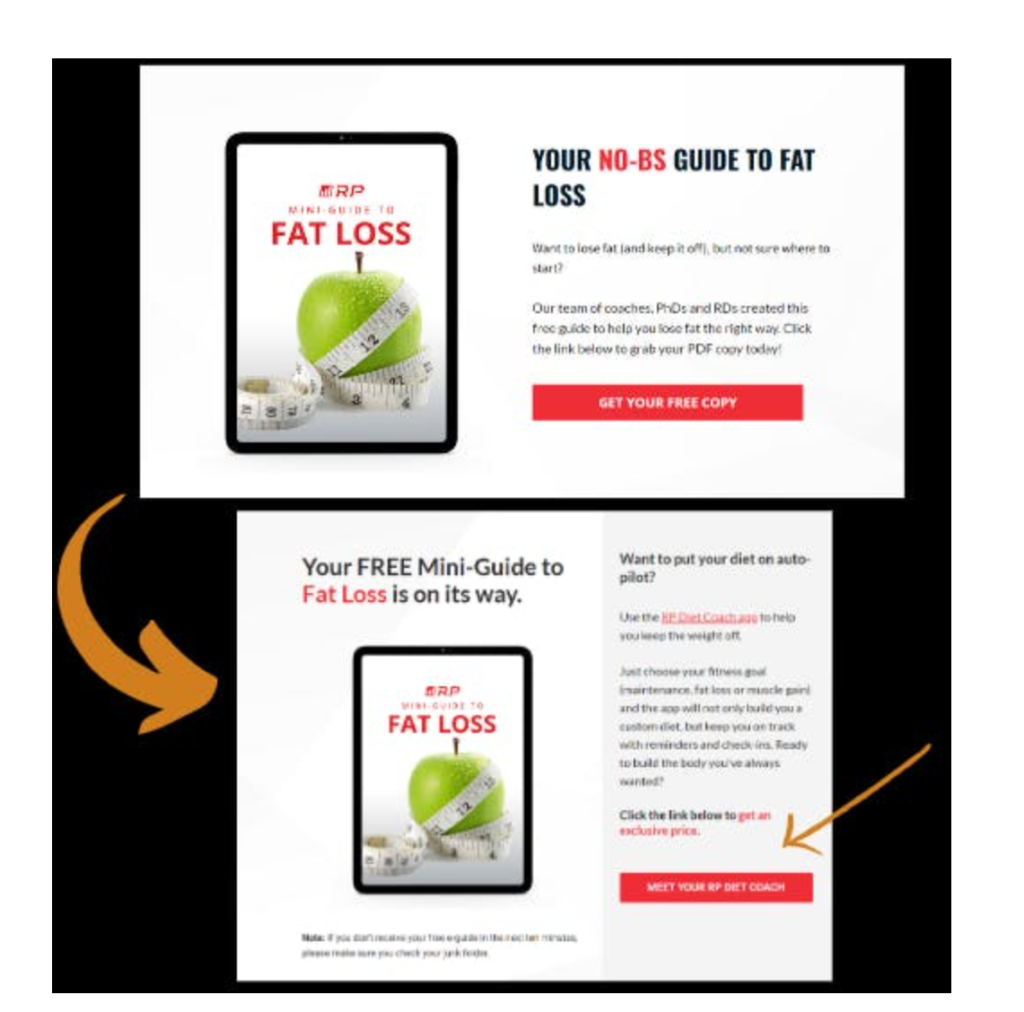
Only 2 steps, but HIGHLY effective.
Which brings me to an important point – not EVERY value ladder needs to have 5 rungs. I know I said it once, but I want to emphasize it again because it’s an important concept to understand.
Often times, the simpler the better.
JK Molina has built a 7 figure business with 3 rungs on his macro value ladder. He has a free offer to join his newsletter, a main offer to join his community, and a backend offer for exclusive access to him.
He also has a webinar micro value ladder that has a frontend offer to join the webinar, main offer to join his community, and a backend offer for exclusive access to him.
He skips certain rungs and doesn’t include others. That’s the cool part about value ladders. You can design them to fit YOUR business!
Why Every Creator Needs a Value Ladder
You might be thinking, “These value ladders SOUND cool, but do I really need one for my business?”
The short answer is yes. You absolutely do.
But not for the reasons you’d expect.
1. Customer Journey
Value ladders force you to NAIL your customer journey.
You have to know their challenges at each step of the ladder.
It informs the products/services you offer.
At each step, the solution you provide should increase their awareness, nudging them to a higher rung.
Value ladders also let you know exactly where your customer is on their buying journey.
Imagine if you get on a sales call and you know a customer has downloaded 3 different products.
Now you know exactly where to go next and how to pitch them.
2. Growing With Your Customers
As you grow your business, your customers grow too. A frontend offer isn’t good enough anymore. They want more. You could go out and find NEW customers. Or give the ones you already have more value.
I like option 2.
For example, let’s use weight loss again.
After I’ve gone through a beginner diet and exercise program, I might want to get more aggressive. If all you do is beginner diet plans and exercise programs, you’re going to lose a customer.
But being the savvy business owner that you are, you created a value ladder and have a “Peak Performance” offer as well. Now you’ve just extended the LTV of that customer.
Happy faces all around.
3. Helping As Many People As Possible
When you believe in what you do, turning people away SUCKS.
You want to help everybody who needs it.
But you have a business to run. And some people can’t afford your services.
That’s the beauty of a value ladder. You can serve ANYBODY who wants help with different products.
Price is no longer the constraint for serving more people.
4. Testing and Iteration
You can quickly test and iterate on different steps in the value ladder.
If one piece isn’t working, you get data and real time feedback.
No more building in a vacuum.
You build products/services.
Put them in the ladder.
And see what works.
From there, you can iterate faster.
Especially for the earlier stages of your value ladder, this is one of the largest (and often overlooked) benefits of building a value ladder.
Wrapping It Up
If this all seems a little abstract, don’t worry. I’m dropping a post on Sunday about how a digital marketing agency could build out an SEM micro-offer.
Turn on notifications so you don’t miss it!
If you can’t already tell, value ladders get me FIRED up. I could keep going on and on, but this letter is already getting long enough, and I’m sure you don’t want to hear from me any more.
So with that, I’ll bid you farewell.
Enjoy the rest of your week Ladder Creators 🫡.
